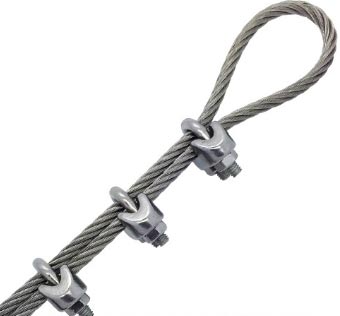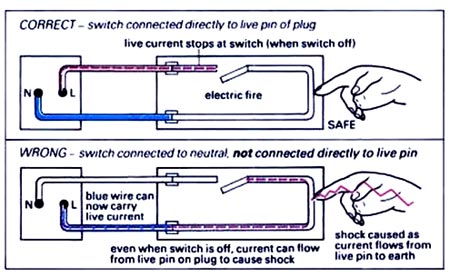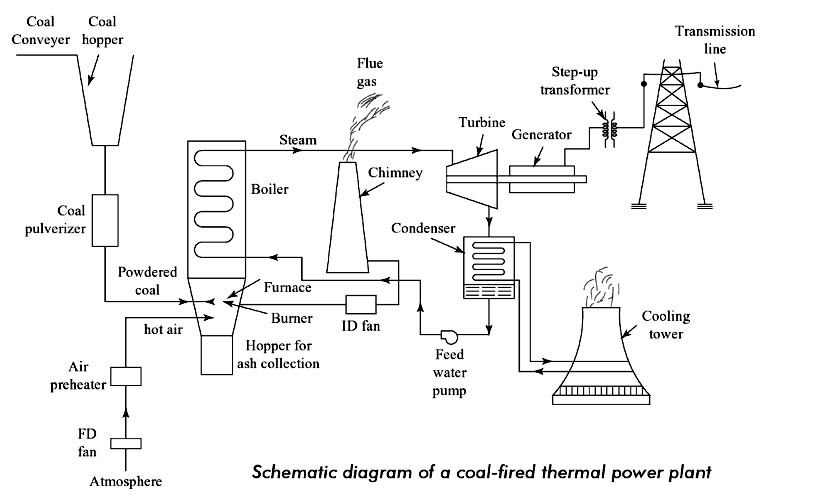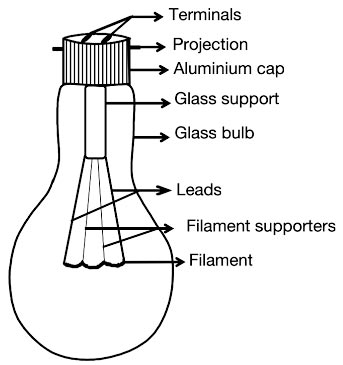Ques.71. The main source of the hydro-electric power station is
- Coal
- Generator
- Water✓
- Nuclear
“Hydro” is a Greek word meaning water. “Hydropower” means the power in the moving water, and hydroelectric is the process by which hydropower is converted into electricity. The hydroelectric power plant harnesses the energy of the hydrologic cycle. Note:- The main source of the Nuclear power plant is Uranium.
Ques.72. The function of the circuit breaker is
- To safeguard the circuit✓
- On and off the circuit
- To save human life
- None of these
Circuit breakers are a mechanical devices designed to close or open contacts members, thus closing or opening of an electrical circuit under normal or abnormal conditions. The main duty of the circuit breaker is
Ques.73. Wiring clips are usually made of
- Copper
- Steel✓
- Brass
- Aluminum
Wire Rope Attachment (Wiring Clip) Many attachments can be fitted to the ends of wire rope so that the rope can be connected to other wire ropes, pad eyes, dead ends or equipment. A wire rope clip sometimes called a u-bolt clamp or u-bolt clip is used to clamp the loose end of a length of wire rope, once it has been looped back to form an eye. These fittings consist of a U-bolt and have a saddle secured by two nuts. Drop forged steel are excellent for use as guy wire clamps for heavy-duty guying applications because they are both strong and resistant to corrosion.
Ques.74. The switch unit need not be on the what type of wire
- Phase
- Neutral✓
- Earth
- Any of the above
Switches are used to turn an electric appliance on and off. It works as a manually controlled protective device. For interruption of the flow of current. In case of an accident where someone touches the live wire and get an electric shock, a switch can be used as a safety device to cut off the current. It should be noted that all the switches are put in the live wire so that when we switch off an electrical appliance (like an electric iron), then its connection with the live wire is cut off and there will be no danger of an electric shock if we touch the metal case of the electrical appliance. If, however, we put switches in the neutral wire, then the live wire will be in connection with the electrical appliance ever when the switch is in the off position, and there is a danger of an electric shock.
Ques.75. One unit of electrical energy equals
- 1 kWH✓
- 1 WH
- 10 WH
- 100 WH
Ques.76. Filaments of electric bulbs are usually made of
- Nichrome
- Carbon
- Copper
- Tungsten✓
Filaments of the electric bulb are made up of tungsten. When a wire heats up a high temperature, its energy change into light energy. So an electric flow of the filament heats it up and produces light. In the olden days a carbon film was used but since 1906 tungsten filament came into use. Tungsten can be drawn into very fine wires and has a high melting point. It melts at about 3000°C. That is why tungsten can be heated upto very high temperatures. For these reasons, the use of tungsten filaments in electric bulbs came into practice. The vacuum exists inside an electric lamp or an inert gas such as argon is tilled in it. The tungsten filament glows but does not bu because there is no oxygen inside the lamp which is essential for burning.
Ques.77. Insulation resistance is expressed by
- Ohm
- Milli-ohm
- Mega-Ohm✓
- Micro-Ohm
Definition:- The insulation resistance of an insulated conductor is the electrical resistance offered by its insulation, to an impressed voltage, tending to produce the leakage of current through the same. The resistance opposing the flow of current is known as the insulation resistance. Insulation resistance shall be expressed in mega-ohm for a specified length (as for a kilometer or a mile or) 1,000 ft. Linear insulation resistance or the insulation resistance of unit length shall be expressed in terms of the megohm-kilometer, or the mega-ohm mile, Insulation resistance of the installation depends on many factors such as atmospheric conditions, humidity, dirt, etc. As such its calculation is not possible, but it can be readily measured. Normally the insulation resistance is quite high and can be measured by an instrument called megger usually used for the measurement of high resistance. The main object in performing this test is to ascertain whether the complete wiring is sound enough to avoid leakage current. Insulation testing megger is a portable instrument used for testing the insulation resistance of a circuit, and for measuring the resistance of the order of megaohms in which the measured value of resistance is directly indicated on a scale.
Ques.78. In which of the following equipment, current rating is not necessary?
- Circuit breaker
- Relay
- Isolator✓
- Load break switch
In order to disconnect a part of the power system for maintenance and repair purposes, isolating switches are used. These are operated after switching off the load by means of a circuit breaker. The isolators are connected on both sides of circuit breakers Thus to open isolators, circuit breakers are to be opened first. An isolator is a off-load device that is employed only for isolating the circuit when the current has already been interrupted. They ensure that the current is not switched into the circuit until everything is in order. Isolator operates under no-load condition. They are not equipped with any arch-quenching device and don’t have any specified current breaking capacity or current making capacity.
Ques.79. Which type of fan used between dust collector and chimney in thermal power plant?
- Induced Draft✓
- Forced Fan
- Ceiling Fan
- Table Fan
Draft in a heating system refers to the pressure difference which causes a current of air or gases to flow through a combustion chamber, flue, or chimney. A natural draft is a draft obtained without any mechanical means. It is the heat of the combustion processes that create the differential pressure causing the draft. The mechanical draft is created by fans that either force or pull the air or combustion products through the system. Mechanical drafts are of two types:- ID (Induced Draft) fan is always located between dust collector and chimney. ID fan handles the flue gases i.e. hot air. ID fan takes the hot flue gases from furnace via dust collector (dust separation system or Fume Extraction system) and delivers to the chimney. In the induced draft cooling towers, the fan is located at the top and air enters from the openings located at the bottom. ID produces pressure lower than the atmospheric pressure in the system or we may say that ID fan will produce the negative pressure inside the furnace avoids any backfiring through any opening. An electrostatic precipitator is used before the ID fan to collect the fine dust particles so that these are not thrown into the atmosphere along with the flue gases and pollute the atmosphere. This is a must requirement provided by the environmental protection law, and the power stations have to abide by this requirement of installing dust collectors from the flue gases. Forced Draft fans suck air from the atmosphere, for providing the required quantity of hot air to the furnace for smooth and uniform combustion of fuel. they handle cold air. So they need low maintenance, consume less power (as pointed out, cold air has high density) and therefore their operating costs are low. The number of FD fans used is generally less than the number of ID fans. FD fan is placed before the boiler & forces the air to the boiler.

Ques.80. Who invented the electric bulb?
- Tesla
- Marconi
- Edison✓
- Benjamin
An Electric Bulb was invented by Thomas Alva Edison in 1879. It is a glass bulb, spherical at the bottom portion and extended to a cylindrical shape at the top. It contains an inner gas like argon or helium at low pressures. Inside the glass bulb, a tiny conducting coiled-coil of the tungsten wire having high resistance is fitted and is called the filament of the bulb.





